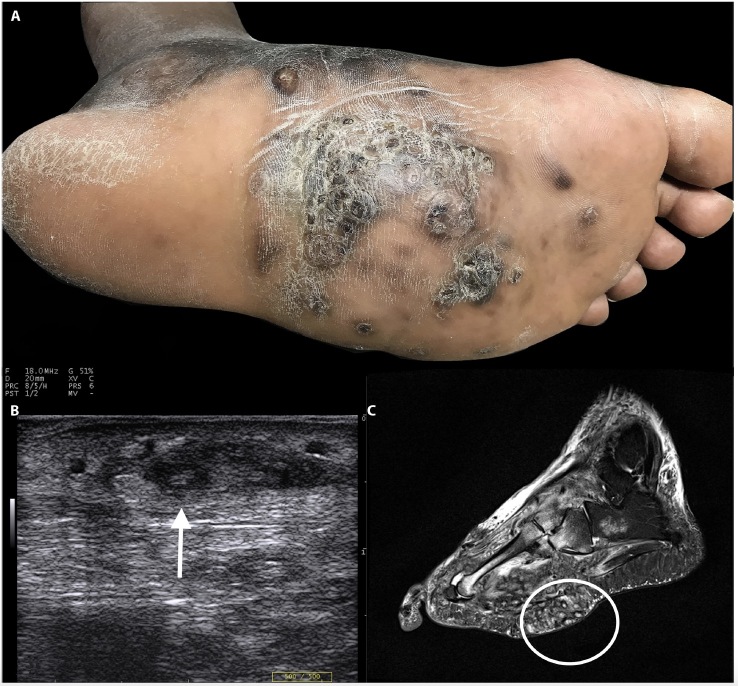Case Presentation
A 65-year-old man from Senegal presented to our Clinic with a 15-year history of a nodular enlarging mass on his left foot. Clinical examination revealed a large painless lesion with crusting and purulent discharge (Figure 1A). The lesion gradually enlarged, leading to deformity and walking impairment. Before biopsy, we performed an ultrasonography which showed hypoechoic areas containing hyperechoic foci, a typical “Dot in a circle” sign (Figure 1B). A subsequent MRI of the foot confirmed ultrasound findings, revealing well-defined hyperintense lesions with peripheral hypointense rim and central hypointensities, confirming our hypothesis of mycetoma. In addition an underlying osteomyelitis was diagnosed (Figure 1C). After a first negative culture, we collected new skin samples under ultrasound guidance which resulted positive for Staphylococcus caprae and Bacillus pumilus. The patient was treated with ampicillin, after a surgical debulking.
Figure 1.
(A) Painless mass of the plantar surface of the left foot with a purulent discharge. (B) Ultrasound (14–20 MHz Us Transducer – MylabTMOne, Esaote) evidenced a hypoechoic area containing hyperechoic foci, due to granulomatous reaction to bacteria grains. (C) Sagittal T2 weighted STIR MRI confirms the presence of “dots in a circle sign” associated to osteomyelitis.
Teaching Point
Madura foot or mycetoma is endemic disease in tropical regions and takes its name from the Indian city of Madurai, where it was described for the first time. Its clinical presentation, typified by sinuses, subcutaneous nodules and purulent discharge, is due to a granulomatous reaction to fungal hyphae (Eumycetoma) or bacteria (Actinomycetoma) aggregates - the “grains” [1]. These pathological findings can be assessed with different diagnostic tools. For instance, Dermoscopy displays multiple papules, disappearance of skin furrows and fistulous tracts extruding grains. In additional other dermoscopic features include blood spots, erosions, orange-yellowish structureless areas [2]. Ultrasonography seem to be more specific showing a peculiar aspect called “dot in a circle” [3], which correlates directly with the presence of grains. Microbiological culture from skin biopsy is necessary to confirm diagnosis but often results difficult, delaying treatment. Ultrasound is rapid and low-cost technique – available also in Dermatology Clinics-which assists early diagnosis and helps appropriate specimen collection for culture, avoiding multiple surgical interventions.
Footnotes
Funding: None.
Competing Interests: None.
Authorship: All authors have contributed significantly to this publication.
References
- 1.Verma P, Jha A. Mycetoma: reviewing a neglected disease. Clin Exp Dermatol. 2019;44(2):123–129. doi: 10.1111/ced.13642. [DOI] [PubMed] [Google Scholar]
- 2.Errichetti E, Ankad B, Chatterjee M, Calzavara-Pinton P, Maione V, Chauhan P. Mycosis. In: Errichetti E, Lallas A, editors. Dermoscopy in General Dermatology for skin of Color. 1th ed. 2022. pp. 132–133. [DOI] [Google Scholar]
- 3.Petscavage JM, Richardson ML. Madura foot masquerading as a hemangioma. Radiol Case Rep. 2015;5(1):355. doi: 10.2484/rcr.v5i1.355. [DOI] [PMC free article] [PubMed] [Google Scholar]



